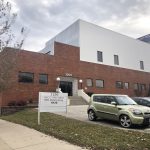Area Residents Asked to Adopt a Storm Drain
Sweet Water Looking to Add 100 Adopters

Sweet Water is looking to recruit at least 100 more storm drain opters throughout the area. Photo courtesy of Sweet Water.
Milwaukee – This summer, a local water group is urging area residents to “Adopt Your Drain.” Sweet Water currently has 245 storm drain adopters and is looking to recruit at least 100 more.
Becoming a storm drain “parent,” doesn’t require much work at all.
Twice a month, adopters check their drain and remove litter, leaves, sticks, dirt or anything else that collects on or around it. Removing debris before and after rainstorms is key.
Drains available for adoption are located throughout the Milwaukee area, ranging north and south from Cedarburg to South Milwaukee and east and west from downtown to Wauwatosa. An interactive online map identifies drains that are in need and whether the drain flows into a river or lake or funnels to a sewer.
“Taking care of a storm drain is an easy way to help keep our rivers and lakes clean and healthy so we can all enjoy the beauty and vibrancy these natural bodies of water add to our neighborhoods and communities,” says Jake Fincher, executive director of Sweet Water.
Drain Debris Disposal
For those who become drain adopters, disposing of the debris is easy.
- Leaves, twigs, grass clippings and dirt/sediment can be composted.
- Sediment collected in the spring is likely to be contaminated with salt from the winter months. As a result, sediment collected in the spring should be thrown out instead of composted.
- Glass and plastic bottles, cans, etc. should be recycled.
- Anything else collected can go in the trash.
To adopt a drain, visit adoptyourdrain.com and enter a home address to see drains that are nearby and hoping for a caretaker.
Leaf Lessons
Most residents don’t realize it but leaves can cause a variety of problems.
When leaves decompose, they release phosphorus and nitrogen into the water that can fuel algae blooms that smother waterways. In fact, “blue-green algae” blooms are toxic to humans and wildlife and are considered a public health hazard. Decomposing leaves also suck oxygen out of the water, choking fish and native plants and contributing to fish die offs.
Stormwater Insights
Stormwater pollution is any dirt and debris that enters waterways through the sewer system. In areas with a separate sewer system, what goes down storm drains ends up right in Lake Michigan. In other areas, storm drains discharge into rivers.
In addition to storm drain TLC, green infrastructure is a pollution prevention tool that captures or absorbs rainwater before it reaches a storm drain. Green infrastructure includes: rain barrels, cisterns, rain gardens, native landscaping, permeable pavement, bioswales, stormwater trees, regenerative stormwater conveyence, depaving, green streets and alleys, greenways and land conservation, green and blue roofs and soil amendments.
For more information and to become a storm drain adopter, visit adoptyourdrain.com.
NOTE: This press release was submitted to Urban Milwaukee and was not written by an Urban Milwaukee writer. While it is believed to be reliable, Urban Milwaukee does not guarantee its accuracy or completeness.



















